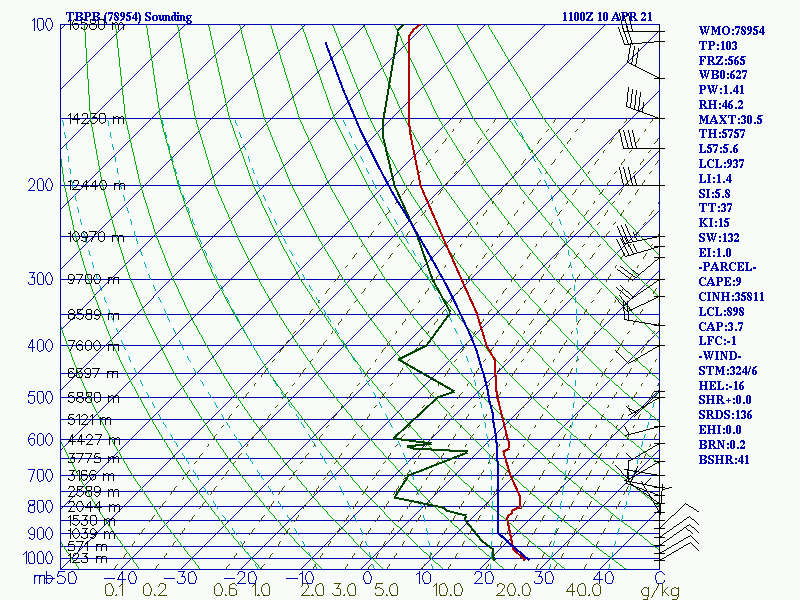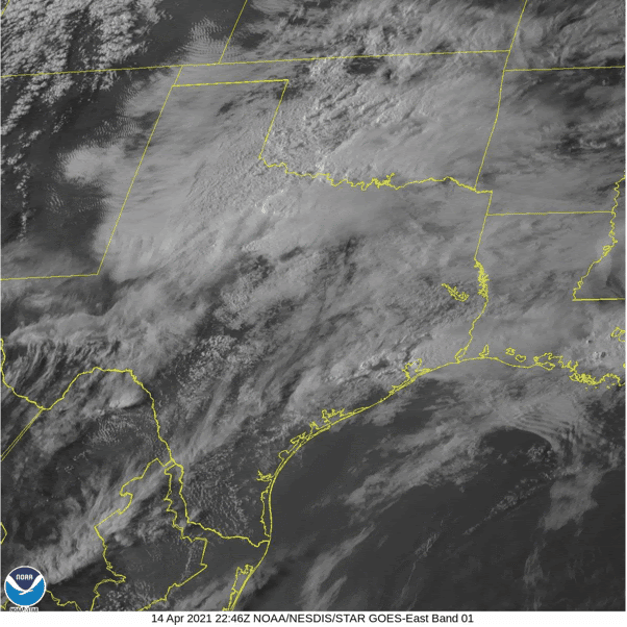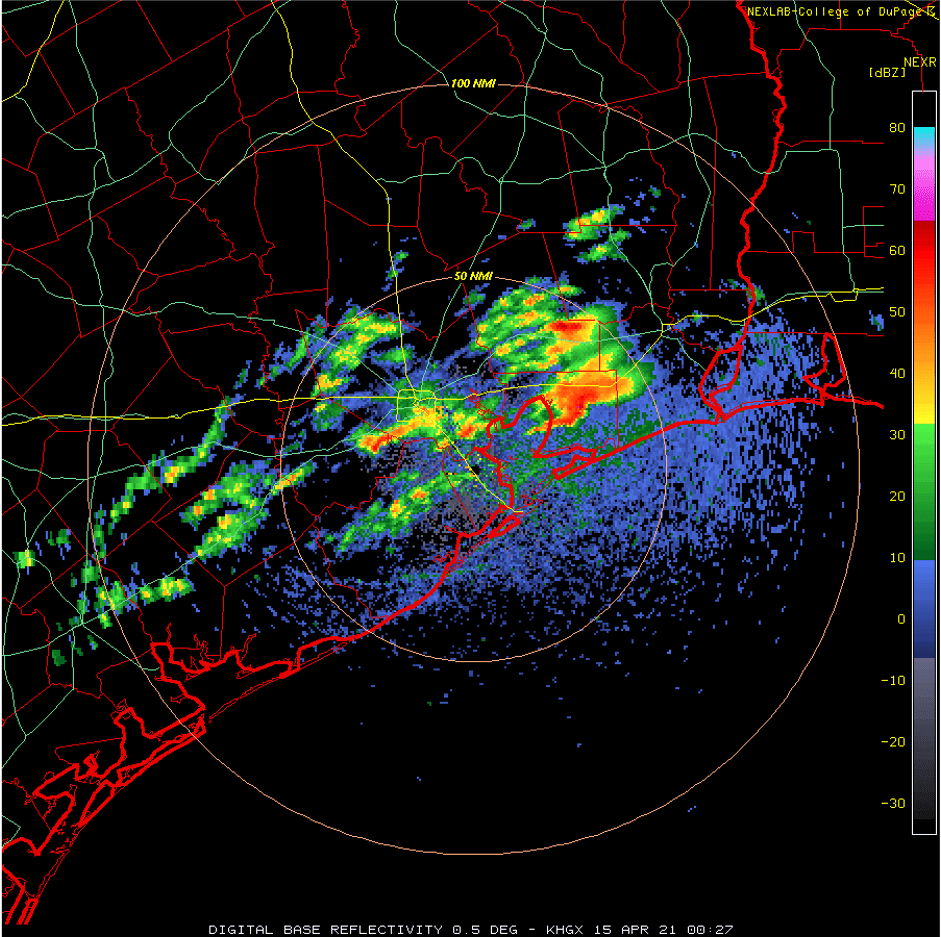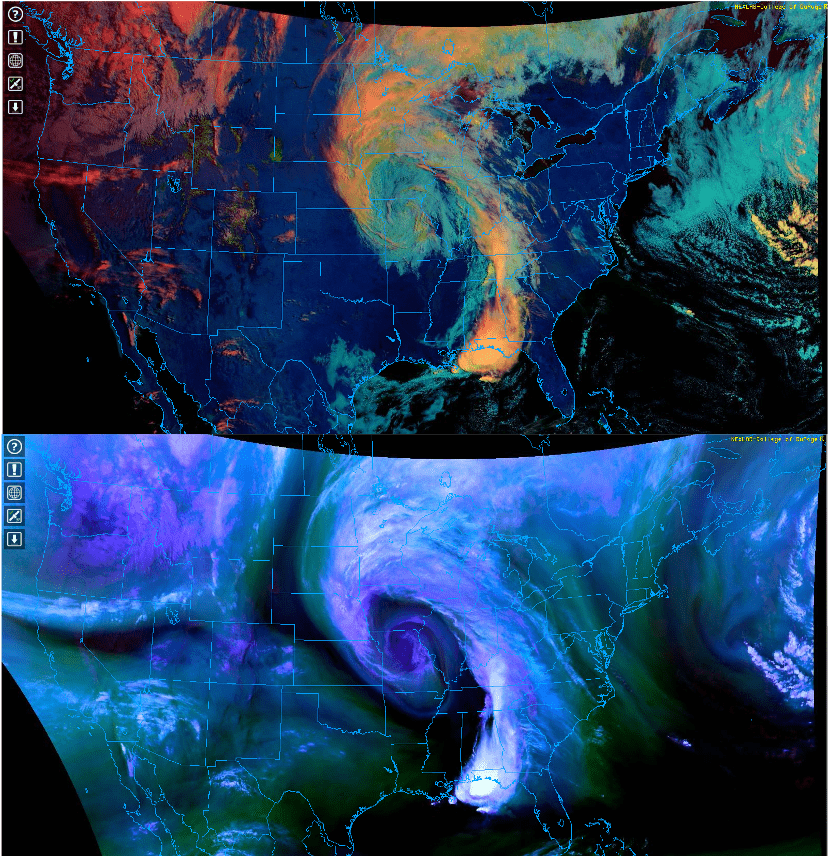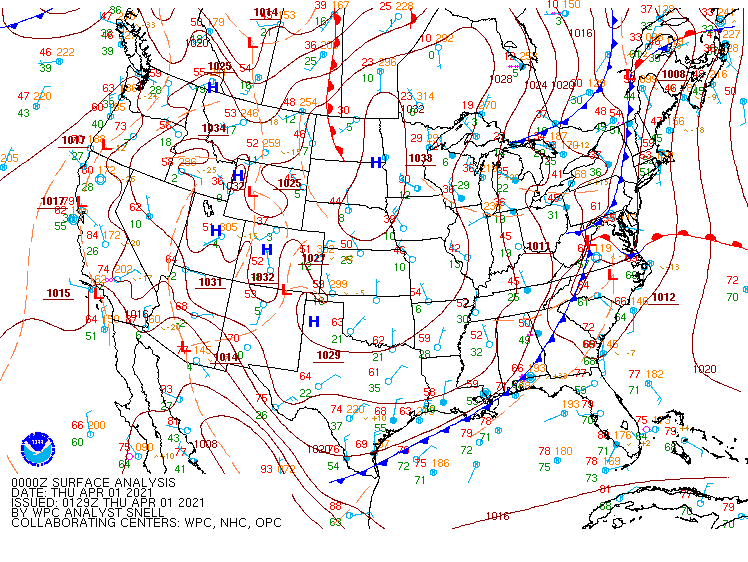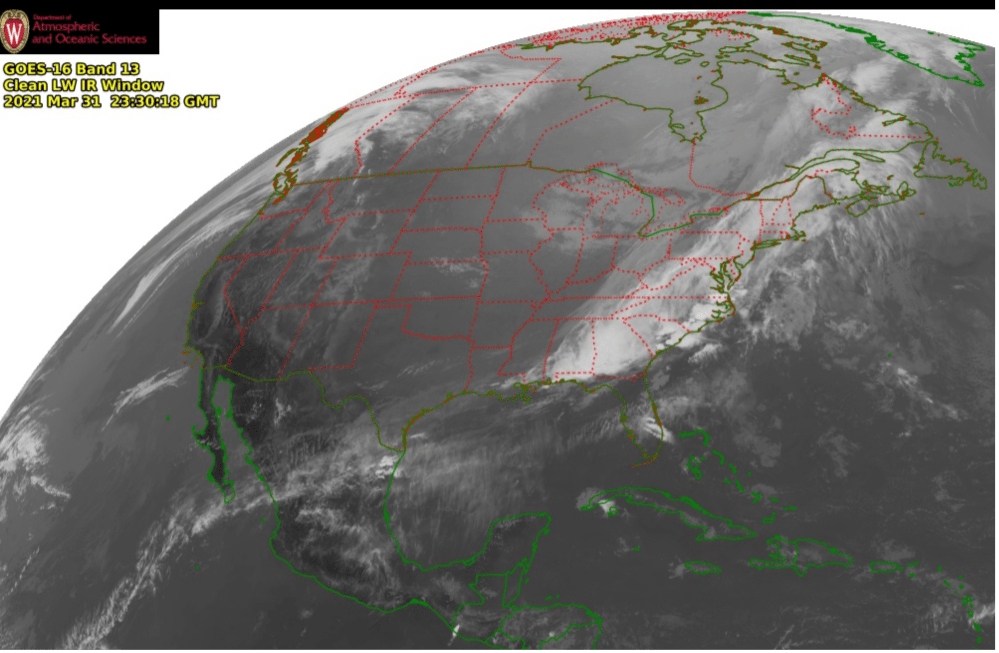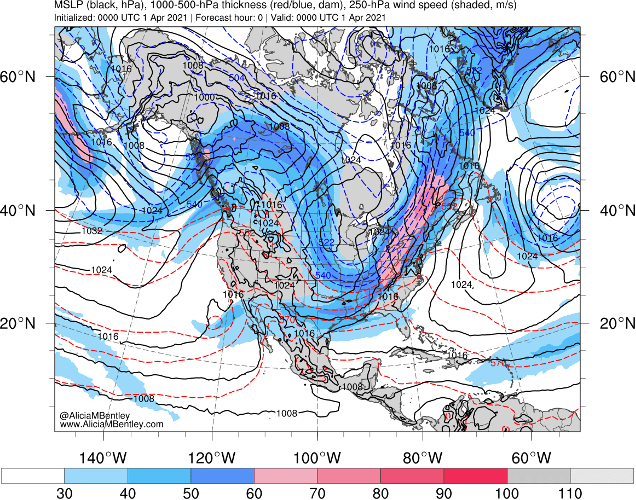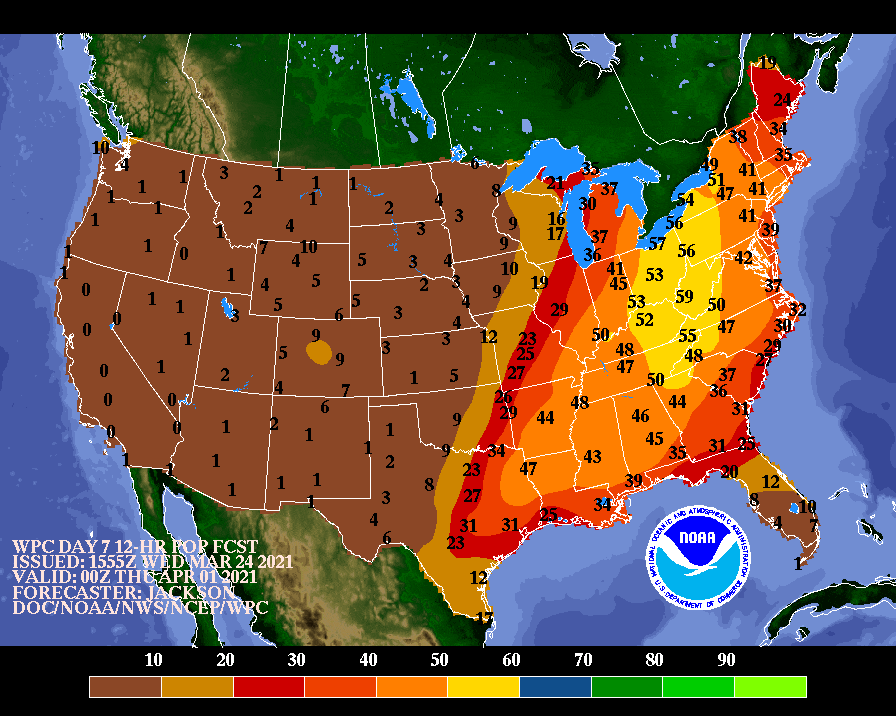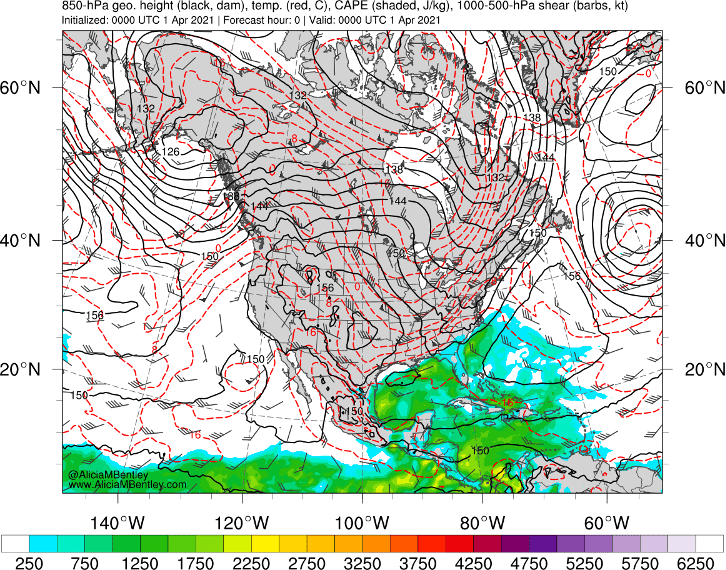
 Fig. 1. WPC surface analysis maps valid at 21Z 7 April 2021 (left) and 06Z 8 April 2021 (right) showing frontal boundaries, high and low pressure centers (blue H’s, red L’s, respectively), sea level pressure (contours, hPa), and surface station plots over the eastern United States, and NEXRAD radar reflectivity mosaic from 15Z-23Z 7 April 2021 [1, 2].
Fig. 1. WPC surface analysis maps valid at 21Z 7 April 2021 (left) and 06Z 8 April 2021 (right) showing frontal boundaries, high and low pressure centers (blue H’s, red L’s, respectively), sea level pressure (contours, hPa), and surface station plots over the eastern United States, and NEXRAD radar reflectivity mosaic from 15Z-23Z 7 April 2021 [1, 2].
Wednesday evening into Thursday morning, a double-low extratropical cyclone feature was centered over the central U.S. with cold frontal boundaries extending from southern Minnesota to eastern Texas. As indicated above in surface analysis maps, the double-low eventually merged into a single deeper low (coming in at 996 mb at 06Z 8 April 2021) and also forming with it a double cold frontal boundary extending to the south of the low pressure center now located in central Iowa. By 03Z 8 April 2021, the precipitation and convective activity associated with this extratropical cyclone and accompanying frontal boundaries encouraged the issuance of a handful of severe thunderstorm warnings across the storm chasing region of the central U.S. and a tornado warning in the vicinity of Shreveport, Louisiana. Radar imagery shows core and gap structures in the rainbands as well indicating horizontal wind shear present. Wind shear and forcing from frontal boundaries propagating through the region fired up some intense convective activity and precipitation observed in multiple cold frontal rainbands extending from the low pressure center to the Gulf Coast.
 Fig. 2. “Natural” Color, Channel 13 Infrared, Day Cloud Phase RGB, Airmass RGB, and Upper Level Water Vapor GOES satellite imagery over the continental U.S. valid at approximately 2030 UTC 7 April 2021 [2, 3].
Fig. 2. “Natural” Color, Channel 13 Infrared, Day Cloud Phase RGB, Airmass RGB, and Upper Level Water Vapor GOES satellite imagery over the continental U.S. valid at approximately 2030 UTC 7 April 2021 [2, 3].
Satellite imagery shows a clear Comma-head structure to the north of tailing rainbands to the south with the center of the low circulating in the vicinity of the Iowa-Nebraska border. “Natural” Color imagery gives an indication of where frozen precipitation may be occurring in the “comma-head” region where colder air is usually located with extratropical cyclones as well as where intense convection is located (along the frontal boundary to the south) through cyan coloring of frozen cloud particles. In IR imagery, we observe intense cold brightness temperatures associated with the higher cloud tops and intense convection along the cold frontal boundaries. In the Day Cloud Phase RGB imagery, the yellowish colors indicated thick cloud structures with frozen particles at high altitudes associated with intense convection along the cold front front, while bluish colors indicated liquid droplets in clouds at low altitudes. The Airmass RGB imagery gives us an indication of where anomalously high potential vorticity (PV) is located via red-orange colors. Thus, it is an indication of where the jet stream is located (observed ridging over the rockies, slightly dipping south just upstream of the extratropical cyclone, and ridging again over the eastern U.S.) as well as potential intrusions of stratospheric air into the upper troposphere (observed just to the south-southeast of the low pressure center). Airmass RGB also gives an indication of the contrast in air masses at play with this extratropical cyclone via greens indicating warm moist air and blues indicating colder drier air. Upper Level Water Vapor imagery also shows the jet stream and a dry air intrusion being ingested into the extratropical cyclone at this time, indicating the likelihood of cyclogenesis (strengthening of the cyclone).



 Fig. 3. Dual-pol WSR-88D imagery from Duluth, Minnesota from approximately 2230Z 7 April 2021 – 0030Z 8 April 2021. Top panel shows base reflectivity, the second panel shows differential reflectivity, the third panel shows base velocity, and the fourth panel shows correlation coefficient [2].
Fig. 3. Dual-pol WSR-88D imagery from Duluth, Minnesota from approximately 2230Z 7 April 2021 – 0030Z 8 April 2021. Top panel shows base reflectivity, the second panel shows differential reflectivity, the third panel shows base velocity, and the fourth panel shows correlation coefficient [2].
Radar imagery from within the comma head region on the northern edge of the extratropical cyclone shows some of your typical more stratiform precipitation for this area in base reflectivity above in Figure 3. The expected base velocity is also observed via radar data. Since Duluth, Minnesota is to the north of the center of cyclonic circulation, the flow field in the vicinity of the radar is expected and observed to be easterly and is shown above as green regions are motion towards the radar and red is motion away. There is also something else going on above called the “bright band” effect, which is where dual-pol radar indicates where the melting layer is. Base reflectivity seems to show a transition from liquid to frozen precipitation as well defined blobs of heavier precipitation give way to lesser intensity, smoother regions of indicated precipitation. Differential reflectivity subtly shows a band of noisy data in a similar region to where the precipitation type changes to the north and northeast of the radar site. Correlation coefficient on the other hand shows a much more distinct region of noisy data where it drops in the same band looking area. The band that is shown in the various radar data is indicative of the melting layer, which is where mixed precipitation is expected and the differential reflectivity and correlation coefficient readings become noisy due to the different types (and therefore shapes and sizes) of precipitation that are present at that level. When looking at surface temperatures and surface observations however, only liquid precipitation was observed and temperatures were above freezing. A quick look at a skew-t showed that temperatures were above freezing up to around 750 mb, giving any frozen precip at higher altitudes time to melt as it fell to the surface.
 Fig. 4. Top left panel shows 250 mb wind speed (fill, kt), streamlines, and mean sea level pressure extrema (red L’s, blue H’s, mb). Top right panel shows 850 mb temperature (contours, °C), temperature advection (shaded, K/hr), frontogenesis (purple contours, K/100 km/3 hr), and wind barbs. Bottom left panel shows mixed layer CAPE (shaded, J/kg), 10m/850 mb/500 mb wind barbs (white, green, yellow barbs, kt), and mean sea level pressure (contours, hPa). The bottom right panel shows a vertical cross section of potential vorticity (shaded, 2 PVU dashed contour), wind out of page (purple contours, kt), and potential temperature (contours, K). All data show from 18Z 7 April 2021 over the continental U.S. [4].
Fig. 4. Top left panel shows 250 mb wind speed (fill, kt), streamlines, and mean sea level pressure extrema (red L’s, blue H’s, mb). Top right panel shows 850 mb temperature (contours, °C), temperature advection (shaded, K/hr), frontogenesis (purple contours, K/100 km/3 hr), and wind barbs. Bottom left panel shows mixed layer CAPE (shaded, J/kg), 10m/850 mb/500 mb wind barbs (white, green, yellow barbs, kt), and mean sea level pressure (contours, hPa). The bottom right panel shows a vertical cross section of potential vorticity (shaded, 2 PVU dashed contour), wind out of page (purple contours, kt), and potential temperature (contours, K). All data show from 18Z 7 April 2021 over the continental U.S. [4].
Other analysis tools shown in Figure 4 give an idea of what could be expected from the extratropical cyclone overnight and the conditions contributing to the weather that occurred. The surface low is shown to be in between an upstream shortwave trough and downstream ridge in upper level flow, and is thus in a region of ageostrophic divergence which can contribute to upward vertical motions and strengthen the cyclone. The temperature advection and frontogenesis present in association with the cold front indicates that the front will likely strengthen and contribute as a forcing mechanism driving convection in the region. Also present in the region is some significant mixed layer CAPE and some decent vertical wind shear, which contributed to the intense convective activity present along the cold frontal boundaries throughout the Southeast. In an attempt to see if any upper level fronts were playing a role in the double cold frontal rainband feature observed in radar reflectivity, the cross section in Figure 4 was taken to see if higher PVU was intruding into the upper troposphere. The telltale dip in 2 PVU altitude near the jet stream is observed with the wind max being right where this slope is steepest, but there doesn’t seem to be a significant intrusion. Therefore, it seems that the double low that merged influenced the propagation of a double cold frontal boundary that provided forcing for the convective activity observed. This extratropical cyclone ended up producing 7 preliminary tornado reports, 59 preliminary wind reports, and 7 preliminary hail reports on 7 April 2021 across the central United States [5].
Sources:
[1]https://www.wpc.ncep.noaa.gov/html/sfc-zoom.php
[2]https://weather.cod.edu/satrad/
[3]https://www.tropicaltidbits.com/sat/satlooper.php?region=us&product=ir
[4]https://www.tropicaltidbits.com/analysis/models/?model=gfs®ion=us&pkg=uv250&runtime=2021040718&fh=0
[5]https://www.spc.noaa.gov/climo/reports/210407_rpts.html





